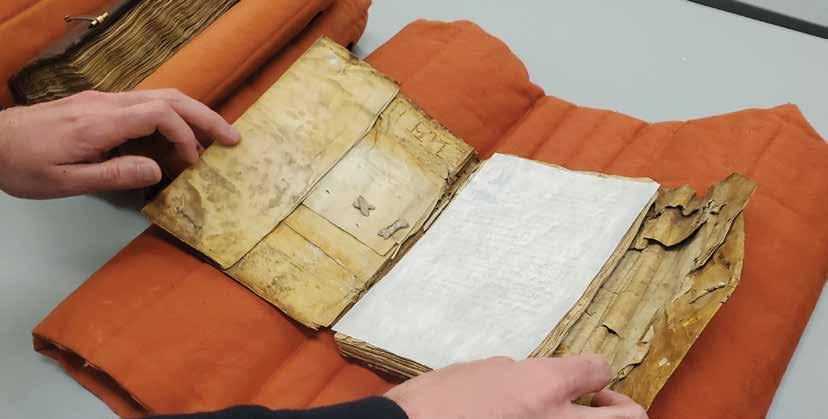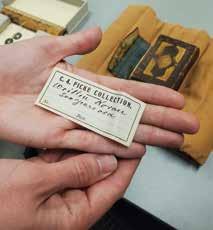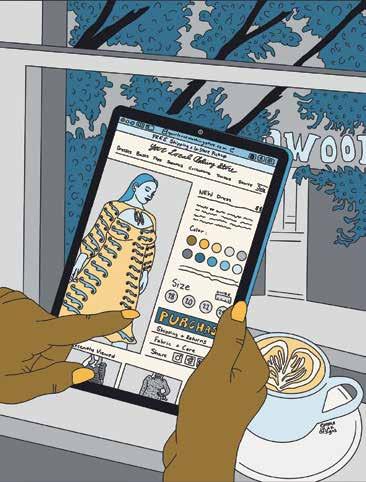
7 minute read
Special Collections
Doodles, Scribbles and Goldleaf
The University of Iowa’s Special Collections paints a colorful picture of medieval books.
Advertisement
By EMMa MCCLaTCHEy
When one imagines a book from the Middle Ages, they likely picture a hefty religious tome, calligraphed by quill-clutching monks and featuring the kind of gilded, illustrated initials that inspired that one episode of Spongebob.
But old books don’t have to glitter to be gold, according to Eric Ensley, medieval scholar and curator of Rare Books and Maps at the University of Iowa’s Special Collections library. One of the jewels of their Middle Ages collection is a stained, crumpled manuscript full of doodles and scribbles, wrapped in an old piece of parchment folded into an envelope, which Ensley compared to a Trapper Keeper.
“This is probably a university textbook,” Ensley said—a “cheap copy” of Cicero’s Ad Herennium, a treatise on rhetoric. “This is one that I just can’t believe we have here at Iowa … books like this don’t survive in huge numbers because they were used to death.”
The book was likely made in the 14th century (the owner wrote down the date, but a bookworm ate a hole right through it) and owned by a student in southern Italy, where Greek, Viking and Middle Eastern cultures collided.
“The paper suggests that they had contact with Arab empires at that time because that’s where paper was coming from,” said Ensley, noting paper hadn’t caught on in Europe yet. “So it’s also telling a story of cultural intermixing in the Middle Ages.”
As for the marginalia, “Students have been doodling in their notebooks forever.”
Ensley fell in love with historic books while working towards his Master’s in library science at the University of North Carolina at Chapel Hill. He chose Yale to pursue his Ph.D. in English, focusing on history and rare books. His goal is to “humanize the Middle Ages” for students researching the era.
“I think when we start to think about people 1,000 years ago, it’s kind of hard to imagine them as human, that they are functioning in a world not so different from our own, that they [had] thoughts and feelings,” he explained.
“These were real people with real lived lives. Not everything was gilded letters or really fancy writing. Some of it was really ugly, but cool.”
There’s little about the Middle Ages collection at UI that’s ugly; even a French nun’s hand-sized book of funerary chants is made more fascinating by a burn near its binding, suggesting she may have leaned too close to a candle while reading.
“We have over 100 medieval items,” Ensley
Visit Special Collections

Have a question on medieval books?
Email the expert at eric-ensley@uiowa.edu
Everyone, not just University of Iowa students and staff, is welcome to visit Special Collections on the third floor of the Main Library, or explore the materials online. Scan the QR code above for the visitors’ guide.
boasted. “We have a huge collection of early printed books—probably one of the best among Big 10 universities. I would put it up against Michigan’s happily, and probably say ours is better, richer.”
He picked up a Latin prayer book bound in impeccably preserved brown leather, a unicorn visible in the embossing, its crisp parchment pages decorated with vibrant illustrations.
“This is like the quintessential item from the Middle Ages,” he said. While it was probably purchased by a wealthy English family in the early Middle Ages as, essentially, an expensive coffee table book, the matriarch of the family would likely have read prayers from it to her children.
“[Books] were status symbols, but they were also testaments to family, as well.”
It resembles a 12th century Arabic copy of the Quran also in the UI collection, leatherbound with beautifully adorned pages. Ensley also showed me a palm leaf manuscript, one of the most common methods of written communication in South Asia dating back to the 5th century B.C.E. Words and images were scratched into dried palm leaves and strung together into skinny and relatively durable little books.
“In the past, when we study the Middle Ages, the idea was that technology is always moving forward, and the printing press is better than the handwritten manuscripts,” Ensley said. “This kind of blows that up, because in the Arab and Muslim world, the printing press didn’t catch on until the 1900s. They were still making manuscripts in huge numbers. The Turks had a very cosmopolitan and intellectual empire based on manuscripts and not really on print.”
Even as technology seemingly progressed in Europe, readers and bookmakers held onto some of the most medieval of scribal traditions. Take a late Middle Ages book in the UI collection, made in the first few decades of the printing press in
Europe. The pages (paper, not parchment) have a glossy feel, all the better to print clear, crisp lettering, detailing the constitutions of Pope Clement VII—making it, essentially, a dull law book. Still, the printers hired artists to hand-illustrate initials and decorate pages with goldleaf like a medieval Catholic missal. Its deerskin binding—today a light tan color, dotted with worm holes—was likely dyed a vibrant pink, according to Ensley. “It’s not until the 1500s and early 1600s that books start to really look the way we think of books looking today,” he said. But at the time this tome was printed and bound, the makers “still wanted to have somebody “these were come in and make it pretty.” real people Not all pretty things can survive over 500 years and with real lived thousands of miles of travlives. not el. Historic books at UI are live in a room kept at everything was 70 degrees Fahrenheit and 50 percent humidity, and gilded letters students and instructors in or really fancy the UI Center for the Book writing. soMe help with any needed repairs. One MFA candidate, of it was Madison Bennett, studied a rare method of making really ultra-thin parchment in the ugly, Center for Book, and has recently become one of the but world’s leading experts on cool.” Emma the centuries-old artform. The tactile aspects of McClatchey 4 studying books and bookmaking of the Middle Ages can help make the time period, and the people of the time, more real for students, Ensley says. “One of the people I studied for my dissertation is a poet named Thomas Hockley, who was also a bookmaker. He was writing for the king at the time. And he talks a lot about scribal labor and how hard it is—the pain he felt, problems with his eyesight, he didn’t make enough money. And these are all very real problems to us today, too,” Ensley said. “There’s a moment in one of his poems where he says that he had a mental breakdown, which is stunning in the Middle Ages to have somebody say, and he calls it his ‘infirmity.’
Dost not thou require gloved hands?
From the University of Iowa Visitor’s Guide to Special Collections & archives: Generally, you will not be required to wear gloves to view Special Collections materials. Gloves can sometimes cause damage to fragile items. As always, we will require that you wash your hands before handling any materials and prefer this to hand sanitizer, which can leave behind a harmful residue. Staff will direct you and provide gloves for the rare exception, such as metals or photographic materials.

He looks in the mirror, and he’s trying to move his face around to make it match so that people would think that he was happy. And when students read this, they’re just like, ‘Oh, my God, this is like me,’ you know, ‘I’ve had times like this, I’ve had depression, I’ve had anxiety.’”
It’s all part of humanizing the oft-mythologized, oft-misunderstood Middle Ages. And while the University of Iowa’s original rare-book library—with an attached chapel and grand stained-glass window—burned down after a lightning strike in 1897, UI curators have spent the last century building a treasure trove of historic tomes.
But if he stumbled upon a time capsule from the Middle Ages, there’s something Ensley would like to find inside more than books: “letters, letters, letters.”
“Imagine a world in which we had so many more letters that we could see what people were interested in—not just what they wrote down in books, but what they scribbled,” he said. “That’s what I want more of, is scribbles.”
Emma McClatchey needs to get herself a girdle book.
Digital is real.

With over 1.25 million article views in 2021, LittleVillageMag.com’s growing audience is more than just a number—74,000 unique monthly
visitors are ready to shop, dine and support local.
For advertising, web design, e-commerce and digital marketing support, contact Little Village today:










